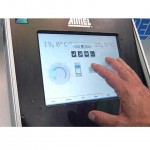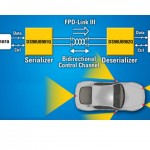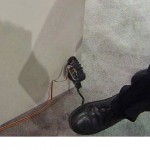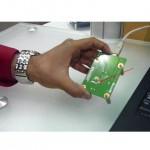Accelerometers for automotive airbag systems showcased the potential for microelectromechanical system (MEMS) sensors when they were first introduced almost two decades ago. With airbags standard on US and other regions’ vehicles, and several sensors used in these systems, the application continues to spawn product advancements. Most recently, STMicroelectronics introduced a new family of high-g acceleration […]
Featured
Proximity Sensing Wakes Sleeping Display
At Convergence 2010 in Detroit, Mich., Atmel’s Stephan Thaler shows how proximity sensing enhances a vehicle’s environment and easily activates a sleeping display. For more information on Atmel’s maXTouch technology and proximity detection, click here. To watch the video, click here.
Proximity Sensing in a Vehicle’s Center Stack
At Convergence 2010 in Detroit Mich., Freescale Semiconductor’s Lydia Ziegler demonstrates how a software library controlled touch sensing can be used for slider and rotary switches in a vehicle’s center stack. The capacitive sensing uses simple metallic electrodes and the software completes the system. The software is an integral part of Freescale’s Xtrinsic touch sensing […]
Communicating Camera Data in the Vehicle
At Convergence 2010 in Detroit, National Semiconductor’s Dac Tran explains how serial-deserialization (SerDes) technology plays a critical role in delivering camera sensing data in vehicles. The SerDes in the demo is National Semiconductor’s FPD-Link III that provides real-time bidirectional control. For more information on National Semiconductor’s FPD-Link III, click here. To view the video, click […]
Four Cameras and Xilinx FPGA Provide Surround View for Vehicles
At Convergence 2010, Xilinx’ Paul Zoratti explains how new vehicle applications for cameras are possible using field programmable gate array (FPGA) technology. With Xilinx SP605 evaluation board, four cameras can be used for a surround view system or decoupled into multiple systems including rear view parking and blind spot detection. The cameras are OmniVision OV9715 […]
Throttle Position Sensing Using Hall Effect Devices
A total of four Hall Effect sensors are used in Micronas’ throttle position demo as explained at Convergence 2010 by Jochen Seidler. The sensor could be a programmable sensor with a ratiomatic, linear output such as one from Micronas HAL 82x family. For more information on Micronas HAL 82x Hall Effect sensors, click here. To […]
Single IR-Based Sensor Performs Ambient Light and Proximity Sensing
At Convergence 2010 in Detroit, Intersil’s Niyant Patel explains how a single infrared (IR) sensor can provide both ambient light and proximity sensing for vehicles. The Intersil ISL29028 ambient light and proximity sensor operates linearly down to 1 millilux and can use 850nm and 950nm external IR LEDs. For more information on Intersil’s ISL29028 ambient […]
Automotive Camera Module Operates in Low-Light Applications
Melexis’ Mark White demonstrates the capability of the Melexis automotive camera module for night vision applications at Convergence 2010. With its high dynamic range and high sensitivity for low light levels and sensitivity to near infrared light, Melexis automotive camera module (ACM), the MLX75403, can be used for night sensing applications. For more information on […]
Touch Sensing in a Remote Keyless Entry System
At Convergence 2010, Atmel’s Toby Prescott demonstrates touch sensing in a remote keyless entry system. The capacitive touch sensing capability is provided by the ATA6617, a LIN system in package solution. Atmel’s QTouch Library enables a number of touch applications. Convergence has been the premier automotive electronics event since 1974. This year’s Convergence had a strong focus […]
Honeywell Extends SMART Position Sensor to 225 mm
Adding to its SMART Position Sensor 75 mm Linear Configuration, Honeywell’s SMART Position Sensor 225 mm Linear Configuration’s simple, non-contact design eliminates mechanical failure mechanisms, reduces wear and tear, improves reliability and durability, enhances operational efficiency and safety, and minimizes downtime. Also, the adaptable, non-contacting design allows customers to eliminate unnecessary connections for installation, reducing […]










